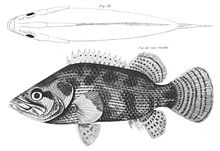
Mahseer is the common name used for the genera Tor, Neolissochilus, Naziritor and Parator in the family Cyprinidae (carps). The name is, however, more often restricted to members of the genus Tor. The range of these fish is from Vietnam in the east and China in the north, through Laos, Cambodia, Thailand, Malaysia, Brunei and Indonesia, and across southern Asia including the countries of India, Nepal, Bhutan and Bangladesh within the Indian Peninsula, plus Sri Lanka, Pakistan and Afghanistan. They are commercially important game fish, as well as highly esteemed food fish. Mahseer fetch high market price, and are potential candidate species for aquaculture. Several of the larger species have suffered severe declines, and are now considered threatened due to pollution, habitat loss, overfishing and increasing concern about the impacts of unregulated release of artificially bred stock of a very limited number of species.

Catla, also known as the major South Asian carp, is an economically important South Asian freshwater fish in the carp family Cyprinidae. It is native to rivers and lakes in northern India, Bangladesh, Myanmar, Nepal, and Pakistan, but has also been introduced elsewhere in South Asia and is commonly farmed.

Channa gachua, the dwarf snakehead, is a species of fish in the family Channidae. The name "dwarf snakehead" is also used for several other species of small snakeheads. C. gachua is native to freshwater habitats in southern Asia, where it has a wide distribution from Iran to Indonesia. This fish is considered to be a species complex, a group of several closely related taxa with one name. It is likely at least three to four different species, and further research may differentiate them. A few species such as Channa harcourtbutleri have been separated from the complex in recent decades. The easternmost population of C. gachua is often recognized as a separate species C. limbata, while the isolated Sri Lankan population often is recognized as C. kelaartii.

Nandidae, the leaffish, are a family of small freshwater fishes which some authorities classify in the order Anabantiformes, but which the 5th edition of Fishes of the World classifies the family and the related Badidae and Pristolepididae outside that order as "sister-taxa". Fishes of the World classified these families and the Anabantiformes alongside Synbranchiformes, Carangiformes, Istiophoriformes and Pleuronectiformes in a monophyletic clade which is a sister taxon to the Ovalentaria but to which the authors do not assign a rank or a name. According to FishBase, the family includes three genera: Nandus of South and Southeast Asia with several species, and the monotypic Afronandus and Polycentropsis of tropical West and Middle Africa. Most recent authorities place the two African genera in the South American leaffish family, Polycentridae, which is only distantly related to Nandus. Another Asian family, Pristolepididae, share the common name leaffish and appear to be more closely related.

Leaffishes are small fishes of the family Polycentridae. According to FishBase, it only includes the genera Monocirrhus and Polycentrus from fresh and brackish water in tropical South America. Although included in the Asian leaffish family Nandidae by FishBase, most recent authorities place the African Afronandus and Polycentropsis in Polycentridae. Polycentridae were formerly placed in the order Cichliformes but are now regarded as being incertae sedis in the subseries Ovalentaria in the clade Percomorpha.
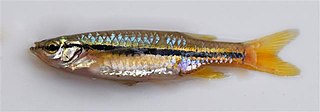
The Indian flying barb, historically flying barb, is one of the species known in the group flying barbs owing to their extremely long barbels. It was discovered as long ago as 1822 by Hamilton. However, it is rarely seen in aquaria. It is found in Myanmar, Nepal, Pakistan, Sri Lanka and India, it is found in many of the same localities as Danio rerio and Danio dangila, an example being the Jorai Rivulet, a tributary of the Sankosh river in Coochbehar district, West Bengal, India. The rare fish Borellius spp. is locally named "Boirali maach". In Nepalese Terai it is called Dedhawa.
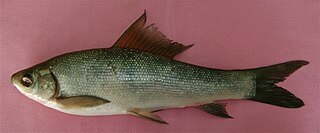
The Kuria labeo is a species of fish in the carp family, Cyprinidae. It is native to Pakistan, India, Bangladesh, and Burma, and it is known from Afghanistan and Nepal.
Gagata gagata is a species of sisorid catfish found in Bangladesh, Myanmar and India. This species grows to a length of 30.5 centimetres (12.0 in) TL. It is native to Asia, found in India, Bangladesh and Burma.
Opsarius is a genus of fish. Its representatives can be found in a variety of countries in South East Asia. These countries include Cambodia, Laos, Thailand, Myanmar, India, and China. Certain species of Opsarius are considered endemic to their respective habitats; such as Opsarius cocsa and Opsariusmaculatus which are endemic to India.

Nandus is a genus of Asian leaffishes native to southern and southeastern Asia.

the African leaffish is a species of African leaffish native to fresh waters of western Africa. Although placed in the family Nandidae by FishBase and by the 5th Edition of Fishes of the World many recent authorities place Polycentropsis in Polycentridae.

Glyptothorax botius is a species of catfish that was first described by Hamilton 1822. Glyptothorax botius is a species in genus Glyptothorax, family Sisoridae and order Siluriformes. IUCN categorise the species as least concern globally. No subspecies are listed in Catalogue of Life.
Glyptothorax cavia is a species of catfish that was first described by Hamilton 1822. Glyptothorax cavia is a species in genus Glyptothorax, family Sisoridae and order Siluriformes. IUCN categorise the species as least concern globally. No subspecies are listed in Catalogue of Life.
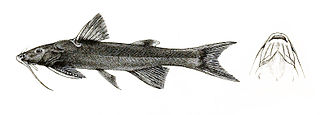
Glyptothorax conirostris is a species of catfish that was first described by Steindachner, 1867. Glyptothorax conirostris is a species in genus Glyptothorax, family Sisoridae and order Siluriformes. IUCN categorise the species as insufficiently studied globally. No subspecies are listed in Catalogue of Life.

Girella nigricans, commonly known as the opaleye or rudderfish, is a species of sea chub found in the Eastern Pacific, from California to southern Baja California. A rarely documented isolated population also exists in the Gulf of California, which might be genetically different from the rest of the species. They are commonly found in shallow waters and intertidal zones, usually over rocks and kelp beds, at depths of 1 to 32 m. They feed primarily on algae, but will occasionally consume sessile invertebrates. They are considered commercially important game fish.

Cabdio morar, the morari, is a species of freshwater fish from the carp family (Cyprinidae). It reaches up to 20 cm (7.9 in) in length. It ranges from Iran, through northern South Asia, to Myanmar. The scientific name of the species was first published in 1822 by Hamilton.

Pristolepis is a genus of fish in the family Pristolepididae sometimes classified in the order Anabantiformes native to freshwater habitats in Southeast Asia and India's Western Ghats. This genus is the only member of its family, a family which, with the families Nandidae and Polycentridae is a group of taxa which are sisters to the Anabantiformes and form part of an unnamed and unranked clade within the series Ovalentaria, closest to the Carangiformes. These three families share the common name "leaffish".
Pangasius myanmar is a species of shark catfish. It is a freshwater, benthopelagic, tropical fish, measuring up to 120 centimetres (3.9 ft) long. It is found from Irrawaddy to Salween and in Rangoon.
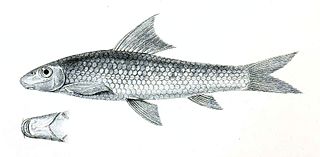
Tariqilabeo latius, also known as the stone roller or Gangetic latia, is a species of ray-finned fish in the genus Tariqilabeo. It is found in India, Bangladesh, Myanmar, Nepal, and China.
The Malabar Leaffish is a species of freshwater fish in the family Pristolepididae. It lives in the Western Ghats in India.
